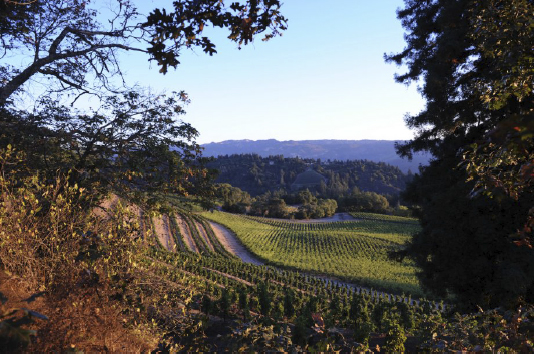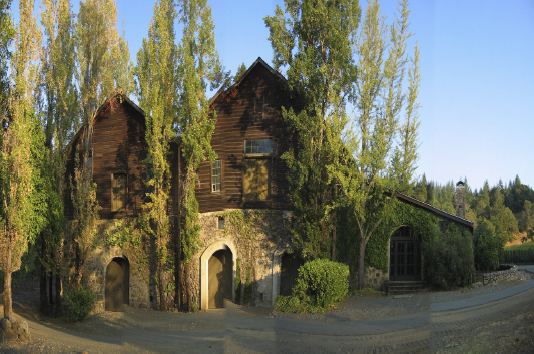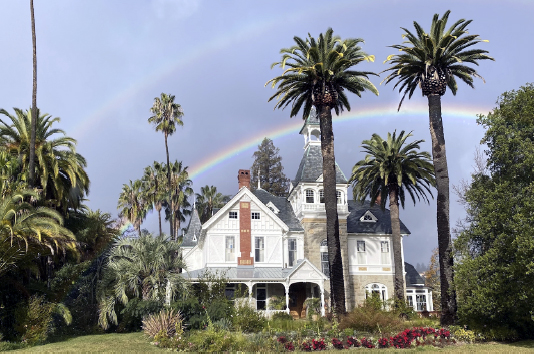Spring Mountain Vineyard: producer profile & 10 wines to try
Decanter
With a history dating back to the 1800s, Spring Mountain Vineyard off ersa glimpse into the age-worthy potential of Napa Valley Cabernet. Although several historical structures were lost in the Glass Fire of 2020,the present team, led by winemaker Barrett Anderson in the cellar, is bullish on a bright future.

Scroll down or click here to see tasting notes and scores for 10 wines from Spring Mountain Vineyard
At present, Spring Mountain Vineyard's portfolio is quite diverse. Still, the winery's most significant bottlings, and most widely distributed, are its Sauvignon Blanc, Estate Cabernet Sauvignon, and flagship Elivette Cabernet Sauvignon.
It's critical to note that Elivette was called 'Reserve' until the 2000 vintage when it was renamed as an homage to current owner Jacob E. Safra's parents, father Eli, and mother Yvette.
Other varietal bottlings include; Cabernet Franc, Chardonnay, Pinot Noir, Syrah, Petit Verdot, a Block Selection Cabernet Sauvignon, and a Block Selection Cabernet Franc.
Evolution after 1969
By 1974, Robbins purchased a 323-hectare property a few minutes south-west on Spring Mountain Road, which included an ageing 1,115-square-metre Victorian house called Miravalle. A house that had been designed by Albert Schroepfer, the architect who had built the Niebaum mansion at Inglenook and the Beringer Rhine House. Robbins restored the mansion, expanded an existing wine cave, and built a winery.
Spring Mountain Vineyards rose to critical acclaim for its wines and aesthetic beauty. The 1973 Spring Mountain Chardonnay – produced by Charles Ortman – was placed fourth in the famous 1976 Judgement of Paris tasting.
During the 1980s, Miravalle served as the backdrop for the prime-time television soap opera Falcon Crest, which aired 227 episodes over nine seasons.
During the Falcon Crest era, the Spring Mountain wines began to fall out of fashion, and Robbins filed for bankruptcy.
In 1992, Swiss financier Jacob E. Safra purchased the estate. Safra replanted the Miravalle Vineyard to Cabernet Sauvignon and Merlot.
He also acquired three adjoining properties: Chateau Chevalier (founded in 1891), Alba Vineyards (established 1979, formerly Streblow Vineyards), and a prized single-site called Draper Vineyards (formerly La Perla, which was founded in 1873)—bringing the entirety of the estate to a sprawling 342.36ha, with 85.38ha planted to vineyards.
The Spring Mountain Vineyard estate is a standard-bearer of the Spring Mountain District AVA. Rising from 121m to 518m, it spreads out over the eastern slopes of the Mayacamas Range, northwest above St. Helena.
Its vines jut out of jagged hillsides in all directions, rooted in a mélange of soils (at least eight of Napa's known 33 various soil series).

Maintaining a Style
In 2019, winemaker Barret Anderson, an alum of Jackson Family Wines, took over from Justin Hirigoyen. Anderson joined Ron Rosenbrand, the longtime vineyard manager, who has overseen the estate since 2003. Rosenbrand's father, Theo Rosenbrand, learned the ropes from André Tchelistcheff while serving as Beaulieu Vineyards winemaker from 1966-1979.
Rosenbrand marvels that some of the grapes he farms—from the old La Perla estate—were purchased in the 1960s and 1970s for BV's famous Georges de Latour Cabernet.
Anderson, thrilled to be working with the estate's 'world-class fruit,' realises his good fortunes. "A lot of the heavy lifting had been done before I arrived," he says of the farming, which includes some organic, and all sustainable practices like no-till, cover cropping and composting, and sheep grazing. Anderson also credits the numerous winemakers before him, going back to Ortman.
Ortman made the wines when Robbins was owner. He set a high bar of quality—crafting wines of restraint, balance, focus, and precision. Wines capable of long-term cellaring. A tasting of older vintages going back to 1979 confirms this. "My focus is to carry the torch at this point and do my best to keep on keeping on," says Anderson.
Spring Mountain Vineyard at a glance
Founded: 1969
Owner: Jacob Safra
Annual production: 168,000 bottles Total hectares planted to vines: 85.38ha Elevation: 121-518m
Key vineyard details: 135 unique and separate hillside vineyard blocks have been identified, all varying in height, slope, soil, sun exposure, and microclimates, harvested typically with multiple passes for different degrees of ripeness—then fermented individually, pending tank space in the winery, and blended later.
Key wines: Sauvignon Blanc; Estate Cabernet Sauvignon; Elivette; Syrah
Estate Cabernet vintages currently available for purchase: 1979, 1985, 1987, 1988, 1992, 1993, 1995, 1997, 1998, 2000,
2002, 2003, 2004, 2005, 2006, 2007, 2008, 2010, 2011, 2014, 2018, 2019.
Top five vintages to try: 1979, 1988, 1993, 2009, 2016
Winemakers: Barrett Anderson (2019 to present); Justin Hirigoyen (2014 to 2018); Patrick Sullivan (2013); Consultant winemakers Patrick Leon & Bernard Hervet (2012 to 2014); Jac Cole (2003 to 2012); Craig Becker (1998 to 2002); Craig MacLean (1994-1998); Tom Ferrell (1991 to 2001); John Williams 1980-1984; Charles Ortman 1971-1979; Knight Michael Robbins 1969-1970
Black magic
The unanswerable question, of course, is, with all the new advancements in technology, will the kind of precision- winemaking that is overtaking cellars worldwide 'keep on' producing truly cellar-worthy wines? Or will the upgrades accidentally break some unheralded winemaking magic?
Depending on who you're talking to, entire vineyards in Napa once suffered from red blotch or leaf roll so badly that grapes could not ripen to their full potential—even if left on the vine until the last respectable moments of the season.
There was the uncertainty of tank space or temperature control and mostly a universal sense of "we didn't know what we were doing." It's the kind of thing vintner Tor Kenward who shepherded Beringer during the 1980s and 90s and through days of Nestlé's reign would, I imagine, chalk up to a certain kind of "black magic."
And there is a bit of black magic encompassing Spring Mountain Vineyards. Barrett Anderson believes wholeheartedly in the magic of the place, as does Rosenbrand and everyone who works there today. So, a few simple mechanical and technological upgrades ushering the winery into this century are positive.
"Changes in the cellar are in the works to improve some processes," says Anderson, "like automatic pump-overs and gentler must-pumps to add control to handling and extraction. My main goal for these wines is to simply be a caretaker of the fruit that comes off the hill."

The devastation in 2020
I toured the steep hillsides and craggy ranges of the Spring Mountain Vineyard estate as a passenger in Rosenbrand's pickup truck in September, two weeks after a spate of intense heat spikes had hit Napa Valley. The temperature registered 48.8 degrees centigrade (120 degrees Fahrenheit) in the vineyards, according to Rosenbrand.
The conversation then turned to The Glass Fire of 2020.
"That was my house," he said, motioning to a nearby foundation, "I lived down there." In the distance, a ridgetop of trees that were once thick, lush conifers now stood in rows of burnt matchsticks, still waiting to be felled. Many others had already been cleared, and the vantage points in all directions were utterly novel.
After the fire ignited on 27 September 2020, Rosenbrand remained on the property. The fire eventually jumped Highway 29 and came toward Spring Mountain Vineyard from two directions. Rosenbrand put his own life in danger to protect the structures around the property, assisting firefighters, but eventually, they all had to go.
Exactly 18 buildings burned in the Glass Fire, including the historical La Perla winery, built in 1873, and the Thomas Church-designed La Perla House at the summit of the estate. "There are no plans to replace these lost buildings as yet," says Dermot Whelan, VP of sales and marketing.
After the flames
The silver lining is that as fires have ravaged Napa, vineyards have been in the spotlight for creating excellent fire breaks. That awareness, coupled with the devastation of the native forest land on the Spring Mountain Vineyard estate, could mean Napa County will permit them to plant more hectares where vines had never been planted—possibly an additional 36ha.
Two years after the fires, in September 2022, Spring Mountain Vineyard filed for Chapter 11 protection under the U.S. Bankruptcy Code. Some American newspapers have questioned the winery's decision to file for bankruptcy. Even suggesting it was an attempt to dismantle pending lawsuits connected to the fires.
"This was not caused by financial or operational hardships," says Whelan, "rather it was a strategic manoeuvre by ownership to refinance our debt obligations with our lender. We plan to continue on a normal course, business as usual, with any needed funding still provided by Mr Safra. We're targeting our emergence from Chapter 11 around the end of Q1 in 2023."
Finding a silver lining
Rosenbrand parked his truck outside the still-standing Chateau Chevalier winery—a stone winery dating back to 1891, adorned with wood-framed windows and wood towers with shingled cupolas and massive redwood doors accented with beautiful ornate stained glass.
It survived the fire, Rosenbrand marvelled. "No firefighter was here. The fire burned all around. See how badly that palm tree is burned right there?" He asked, pointing to the tree a few metres from the building. "And here, there were two right by the front door, and they just burned to a crisp. And yet the door didn't catch."
We stepped through those doors into a grand foyer, which houses a collection of photos. One dated 1916, and there were empty bottles with ornate labels dating back to the 1970s.
The winery was designed for gravity to flow down to the naturally cool barrel cellar where we stood. All of it was supported by massive redwood beams over one hundred and fifty years old. Incredible that it didn't burn.
Thriving in the shadows of waning light
Back outside, we surveyed the estate's eastern-northeastern exposure. "We get a lot more acidity left in the grapes because as the sun is starting to settle, in the late afternoon." said Rosenbrand, "We're getting very little harsh direct sunlight here. And that higher natural acidity is why, I believe, our wines have such longevity and ageing potential."
Stopping near the summit of the estate, looking southeast, we could see all of St. Helena and far down the valley. "Everywhere we looked was devastation, save for one oasis of green," said Whelan.
He motions to a block of lush, healthy vines in front of us—the grapes from here are all reserved for their Elivette Cabernet. Even the rows of vines that had once produced the single-varietal bottling of Petit Verdot I'd quite admired had survived.
With the sun inching its way west, the vines on this knoll were bathed in shadows while the light, coming from behind us, still illuminated the valley below. We grabbed some berries still hanging on the vine, which teemed with deep flavours and tart, zippy acidity—more of that black magic.
Given the depth of Spring Mountain Vineyard's remarkable wine library, they can offer visitors a tasting going back five decades. Often including the 1979 Cabernet Sauvignon.
My five-decade tasting confirmed that the wines of Spring Mountain Vineyard are real treasures of Napa—meant for enjoyment now and, as we will see—later. Much later.